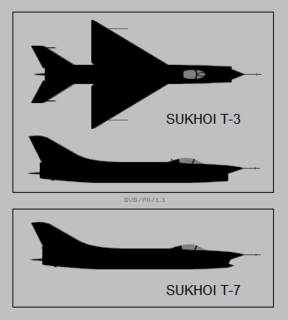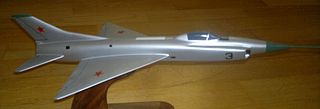Related Research Articles

The Tupolev Tu-110 was a jet airliner designed and built in the USSR, which saw its maiden flight in 1957.
The Sukhoi Su-9 or Самолёт K ;, was an early jet fighter built in the Soviet Union shortly after World War II. The design began in 1944 and was intended to use Soviet-designed turbojet engines. The design was heavily influenced by captured German jet fighters and it was subsequently redesigned to use a Soviet copy of a German turbojet. The Su-9 was slower than competing Soviet aircraft and it was cancelled as a result. A modified version with different engines and a revised wing became the Su-11, but this did not enter production either. The Su-13 was a proposal to re-engine the aircraft with Soviet copies of the Rolls-Royce Derwent turbojet as well as to modify it for night fighting, but neither proposal was accepted.

The Ilyushin Il-30 was a Soviet turbojet-powered tactical bomber designed as a higher-performance, swept wing version of the Ilyushin Il-28, in the late 1940s. Its thin wing and engine nacelles necessitated the use of tandem landing gear, the first Soviet aircraft to do so. It was apparently canceled before the prototype made its first flight, although sources disagree with this.

The Lyulka AL-7 was a turbojet designed by Arkhip Mikhailovich Lyulka and produced by his Lyulka design bureau. The engine was produced between 1954 and 1970.

The Lavochkin La-150, was designed by the Lavochkin design bureau (OKB) in response to a 1945 order to build a single-seat jet fighter using a single German turbojet. By this time both the Americans and British, as well as the Germans, had already flown jet fighters and the single Soviet jet engine under development was not yet ready for production. The design was completed quickly, but the construction of the five flying prototypes was protracted by the factory's inexperience in building metal aircraft. The aircraft made its first flight in September 1946, but proved to require extensive modifications to meet the Soviet Air Forces' requirements. These took so long to make and test that the aircraft was essentially obsolete by the time that they were completed. Even one variant with a much more powerful engine was inferior to other aircraft that the OKB had under development and all work was terminated in 1947.
The Sukhoi Su-10 or Izdeliye Ye was a Soviet turbojet-powered bomber aircraft built shortly after World War II.

Arkhip Mikhailovich Lyul'ka (1908–1984), was a Soviet scientist and designer of jet engines, head of the OKB Lyulka, member of the USSR Academy of Sciences.

The Sukhoi T-3 was a prototype Soviet fighter aircraft.

The Sukhoi P-1 was a prototype Soviet interceptor.

The Lavochkin La-152,, and its variants, was a jet fighter prototype designed and manufactured by the Lavochkin Design Bureau (OKB) shortly after the end of World War II. Derived from the Lavochkin La-150, the 152 used several different engines, but the program was canceled as other fighters with more powerful engines and swept wings showed more promise.
The Lyulka TR-1 was a turbojet designed by Arkhip Lyulka and produced by his Lyulka design bureau. It was the first indigenous Soviet jet engine.
The Lyulka AL-5 was a Soviet axial compressor turbojet developed from the Lyulka TR-3 turbojet around 1950. It was flight-tested in a number of prototype aircraft, but was not accepted for production.
The Lyulka TR-3 was a Soviet axial turbojet designed after World War II by Arkhip Mikhailovich Lyulka.

The Yakovlev Yak-1000 was a Soviet supersonic technology demonstrator intended to evaluate the aerodynamic layout and field performance of the cropped delta wing discussed in captured German documents in combination with the new Lyulka AL-5 turbojet. The tandem undercarriage proved to be unsatisfactory and there were serious flight stability problems related to the delta wing, enough so that it never flew after an accident during taxiing tests.
The Mikoyan-Gurevich I-75 was the final design of a series of three experimental swept-wing interceptors developed in the Soviet Union in the mid-late 1950s by the Mikoyan-Gurevich design bureau from their Mikoyan-Gurevich I-3 airframe. All the aircraft in the I-3 program were affected by delays in the development of the Klimov VK-3 turbojet engine, its cancellation and ultimate replacement by the Lyulka AL-7F turbojet engine.
The Mikoyan-Gurevich I-3 was the first of three interrelated fighter prototype programs developed by the Mikoyan-Gurevich design bureau in the Soviet Union in the mid/late 1950s – starting with the I-3, continuing with the I-7 and finally evolving into the I-75. On several occasions airframes were rebuilt and/or reused, both within a program or in a succeeding program. All the aircraft in the I-3 program were affected by delays in the development of the Klimov VK-3 afterburning bypass turbojet engine, and its cancellation and replacement by the Lyulka AL-7F turbojet engine.
The Ilyushin DB-4 or TsKB-56 was a Soviet twin-engined bomber aircraft of the early 1940s. It was a development of the Ilyushin DB-3 and was intended as a replacement for the earlier aircraft, but only two prototypes were built; engine problems and the need to concentrate production on existing types following the German invasion of the Soviet Union in June 1941 meant that no more examples were built.
The Tupolev ANT-41 was a prototype Soviet twin-engined torpedo-bomber of the 1930s. A single prototype was built, which was destroyed in a crash. No production followed, with the Ilyushin DB-3 serving as a torpedo bomber instead.
The Mikoyan-Gurevich I-350, was a Soviet Cold War-era experimental fighter aircraft. It was the first Soviet aircraft able to maintain supersonic speed.

The Sukhoi T-49 was a prototype Soviet fighter aircraft.
References
- Gunston, Bill. “The Osprey Encyclopaedia of Russian Aircraft 1875–1995”. London, Osprey. 1995. ISBN 1-85532-405-9